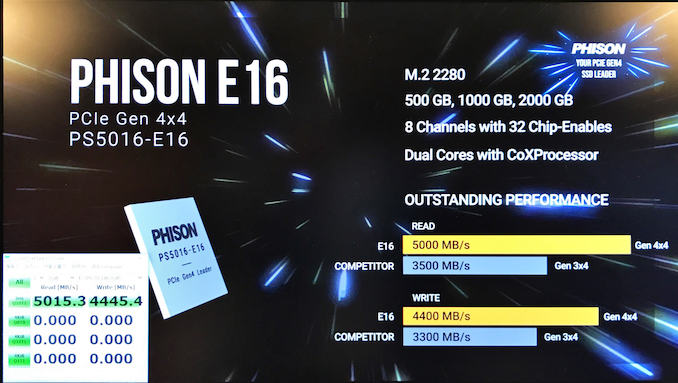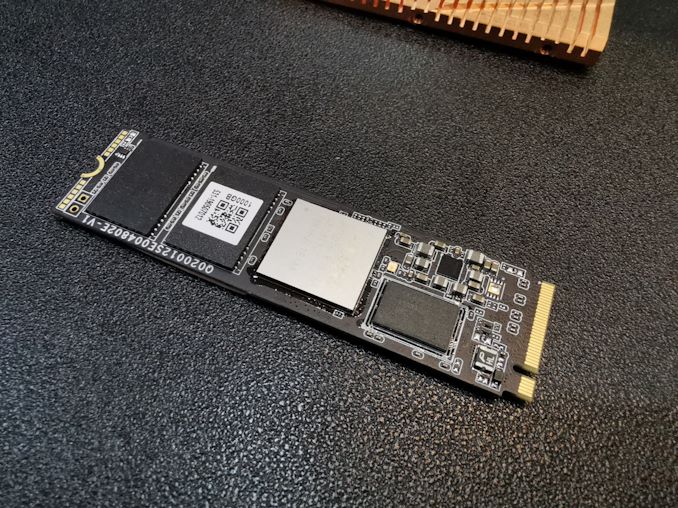Phison’s PS5016-E16 & PS5019-E19: The First PCIe 4.0 Client SSD Controllers
by Anton Shilov on May 31, 2019 12:00 PM EST- Posted in
- SSDs
- Storage
- Trade Shows
- Phison
- Computex 2019
- PS5016-E16
- PS5019-E19

In the recent years SSD controllers and NAND flash memory have become so fast that the PCIe 3.0 x4 interface used by M.2 SSDs has become a bottleneck for sequential performance. As a result, a faster interface is needed to boost the performance of these drives. Coming to the PC market later this year, PCIe 4.0 will increase bandwidth available to M.2 SSDs to around 8 GB/s (each direction) and will enable drive vendors to offer faster SSDs.
To build M.2 SSDs supporting a PCIe 4.0 x4 interface, new controllers are (obviously) needed, and right now the only company that has them ready is Phison. In fact, the company is readying two such controllers: the PS5016-E16 for high-end drives, as well as the PS5019-E19 for mainstream drives. The E16 has eight 800 MT/s NAND channels for ultimate parallelism and sequential read performance of up to 5 GB/s (write speeds depend on the actual chips/SSD capacity, in the best case scenario it is said to reach up to 4.4 GB/s), whereas the E19 has four NAND channels to minimize the die size and cost.
While the PS5019-E19 is formally positioned below the top-of-the-range controllers, it supports all of the features the E16 does (including Phison’s latest implementation of LDPC-based ECC and so on). Phison is also testing it with the latest 3D NAND flash memory devices featuring a 1200 MT/s interface, so if the company qualifies it for such chips, the actual SSDs powered by the E19 will offer performance that will be significantly higher when compared to today’s high-end SSDs at a lower price.
It is noteworthy that in a bid to speed up the commercial launch of its PS5016-E16 and the PS5019-E19 controllers, Phison took its E12 and E13 controllers and swapped out the PCIe 3.0 PHY for a PCIe 4.0 PHY, so these controllers are not completely new from a NAND management perspective. The upside for the company and its customers, however, was that it will allow the company to roll out its PCIe 4.0-enabled controllers ahead of the competition, while also simplifying the development of the controller's firmware.
At Computex, a variety of partners, including Corsair, GIGABYTE, Essencore/Klevv, Patriot, Galax, and a number of others are demonstrating their M.2 PCIe 4.0 x4 drives featuring the Phison PS5016-E16 controller. The SSD suppliers use 3D NAND devices from different makers, so the E16 has been qualified to work with a variety of components, which further strengthens its competitive positions.
The PS5019-E19 will be launched a little later than the flagship E16 controller, but everything points out that it will be made available to SSD makers in 2019 with products to follow shortly.
| Want to keep up to date with all of our Computex 2019 Coverage? | ||||||
 Laptops |
 Hardware |
 Chips |
||||
| Follow AnandTech's breaking news here! | ||||||












12 Comments
View All Comments
Death666Angel - Friday, May 31, 2019 - link
Heh, no 4K numbers in that CDM screen shot. Would rather see more progress in that regard than faster sequential numbers. But I guess if the mark up of PCIe 4.0 NVME drives isn't too high, I will get one for my next system drive and the 960 Evo I have will become my data drive. Fun stuff.ktmrc8 - Friday, May 31, 2019 - link
62.31 MB/s from this CDM screen shot for Q1T1 random 4K read. Article also has RAID 0 stats.https://pc.watch.impress.co.jp/docs/news/event/118...
peevee - Friday, May 31, 2019 - link
4K is not limited by PCIe interface, and anyway irrelevant for consumer workloads. Random 64K would be better today.Death666Angel - Friday, May 31, 2019 - link
Every website I frequent uses 4k testing and none have 64k testing. A quick Google also showed nothing pertaining to your statement that 4k is irrelevant for consumer workloads. And I don't know why you have to mention that 4k is not being limited by the PCIe interface, since I never said or alluded to that being the case.linuxgeex - Friday, May 31, 2019 - link
4k random writes are relevant for consumer workloads, because that affects swap performance. 4k random reads are only relevant on consumer operating systems that implement swap partitions, like Linux, MacOS, and BSDs. Windows uses page files. WIndows does 128k reads to optimise throughput, so 4k random read IOPS are not as relevant for Windows users as a result. Even on Linux, MacOS, and BSDs filesystem reads are 128k unless you configure them otherwise, so unless you're going to swap 4k random reads are also irrelevant... even for enterprise workloads.linuxgeex - Friday, May 31, 2019 - link
I guess I should add that your 4k random read performance on any OS that has filesystem reads configured to 128k read-ahead will be limited to 1/32 of the ideal throughput, simply because 31/32 of the data is going into the VFS buffer and then getting discarded. :-( If you really care about your 4K random read performance, you *must* disable read-ahead.Billy Tallis - Friday, May 31, 2019 - link
That might affect file contents, but I don't think most operating systems perform sequential readahead when walking file system structures while trying to find where the file contents are. And when the file is less than 128kB long, I don't think the readahead continues past the end of the file.ksec - Saturday, June 1, 2019 - link
But it really hasn't shown any improvement in consumer workload. Optane had much better 4K Random, but it hasn't shown any benefits when compares to fastest consumer SSD. Which leads me to believe Seq Read Write is still one of the most important aspect.Mr.Vegas - Friday, September 6, 2019 - link
If you ask anyone that used proper optane drive as boot drive [even the dual channel 58gb/118gb versions] they will tell you that its same feeling going from SSD to optane like from HDD to SSD.Everything is more snappy, programs load faster, even heavy programs like say my Waterfox with 5000+ TABS that loads for 30 second [maybe 40] on SATA SSD, loads almost instantly on optane 900p
GreenReaper - Monday, July 1, 2019 - link
4K random does matter for database use - and there are a surprising number of databases on Windows now, hiding in the background. However, the difference may not be significant for the desktop level of usage.